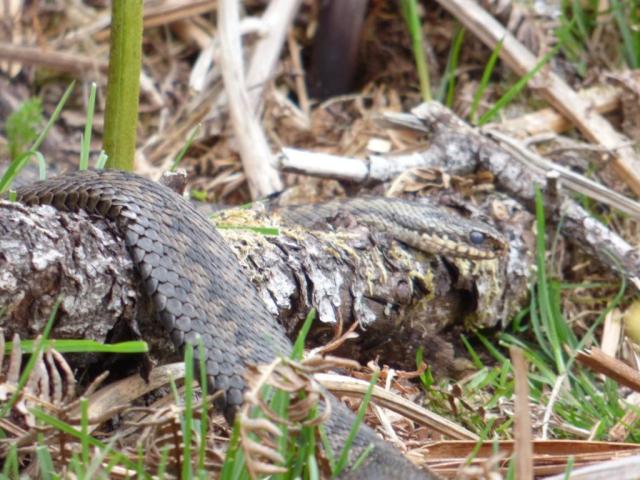Well, the warmth of last week hasn’t lasted. It’s been dry this week- no rain since the weekend- but my goodness, it’s been cold. The frost light even came on in the car one morning! It has warmed up through the day, but it’s taken a long time doing so- its afternoon until you shed a jacket… if you even do. So what has this meant for the wildlife? Well, I can’t imagine its making life easy. The insects have been slow in coming out- good for not getting eaten by midges- but tough for insect-eating birds. But that hasn’t stopped the spotted flycatcher deciding that, yes, she will nest above the back door at Burn o Vat. She even sat tight through the alarm being fixed and repeatedly sounded by the engineer!
I always feel privileged when wildlife chooses to share or make use of “human” space. So often, people and wildlife are incompatible. Look at Chernobyl- the wildlife there has come back, as it can more easily withstand a barely sub-lethal dose of radiation than it can large-scale human presence. It’s both heartening (that nature can recover) and depressing (that we’re so destructive) at the same time.
The trees are all in leaf now. The aspens and ash have finally come into full leaf. For some reason, some of the aspens come out in a vivid spring green, while others have a bronze colour, which soon turns to green, when they first emerge. The trees seem perfectly healthy- the bronze isn’t that of a dying leaf- so I’m not sure why. Maybe just a genetic difference in the trees or different amounts of pigments in the leaf?
The bird cherry are in full flower just now. They come out just after the wild cherry or gean trees and there is a magnificent one near New Kinord. Their blossom has a strange, musky smell- not totally pleasant but not totally unpleasant either. They are alive with insects- walk past one and it hums with the buzzing of bees.
On the woodland floor, some of the early spring flowers are going over. However, new ones are springing up all the time- now is the best time to see the blue bugle and white greater stitchwort.
And now’s the time I’ll be asked what the white, starry flower is that’s appearing in the woods. It’ll be chickweed wintergreen, a lovely, delicate little flower often found in Scottish pinewoods.
Last week’s mystery feathers were from a cuckoo, from its tail to be exact. We suspect it had been eaten by a sparrowhawk, which is ironic- cuckoo plumage mimics sparrowhawk plumage to frighten small birds off the nest, to allow the cuckoo to lay an egg. Even if one has been eaten, there are still at least 3 singing males on the reserve.
We’re seeing lots of feathers down by the lochs just now- but these aren’t from victims of predators. Some of the ducks are already starting to moult into “eclipse”, where they lose their bright, showy spring plumage. The swans also seem to be preening out huge amounts of feathers too.
But some of the swans have other priorities. The first cygnets appeared on the lochs this week, with a brood of six and another brood of four being spotted on Loch Davan.
The lochs are low just now, so there is quite a lot of debris on the “tideline”- bits of weed, rushes, twigs and….green jelly blobs? In among the usual detritus were several large-marble sized blobs of what appear to be green jelly. Now, it’s not uncommon to be asked what a weird, jelly- like blob is, and the answers range from unfertilised frogspawn to fungi to slime moulds to lime-flavoured jelly (there was a kids’ party outside the visitor centre and they dropped some. I felt that needed explanation). These are probably a type of protozoa, a single-celled microscopic animal, that lives in huge colonies (the jelly blob) and has a beneficial relationship with an algae (the green stuff in the blob). They look weird but aren’t uncommon in freshwater across the UK (and, in spite of various on-line fora, aren’t aliens either).
Some of the goldeneye are still thinking breeding thoughts- that male was determinedly displaying to this female, and she seemed interested too. Breeding can be spread out over quite a long season- we had goldeneye ducklings a fortnight ago on Kinord and there’s a new brood on Loch Davan….but some birds may not even have laid eggs yet.
The adders haven’t liked the cold weather. We’ve hardly seen them this week, and when we have, they’ve been flattened out to maximise their surface are to absorb heat. I’m always amazed just how much they can flatten- I actually approached this female to check she was alive, as it didn’t seem possible she was that flat and still alive! I doubt much of her body was thicker than 1 ½ cm and the scales were really standing up in the edge. However, it’s supposed to warm up this weekend, so hopefully the weather will get a bit better for the wildlife- and us!


















